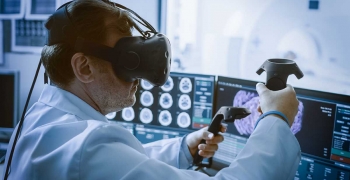Medical imaging is often seen as the backbone of modern healthcare. From diagnosing critical diseases to planning treatment pathways, imaging technologies like MRI, CT, and X-rays offer vital insights into patient health and help doctors and caregivers decide on the care paradigm.
The global medical imaging market was valued at about USD 42 billion in 2024, and is projected to grow to upwards of USD 68 billion by 2032, exhibiting a CAGR of 6.4% during the forecast period. Asia Pacific dominated the market, with a share of 38.61% in 2024.
However, healthcare systems continue to face challenges such as diagnostic delays, overburdened radiologists, and the need for greater accuracy.
Revolutionizing Diagnostics with AI and Cloud Computing
The growing adoption of AI and cloud computing in medical imaging is increasingly becoming integral to the future of healthcare diagnostics. AI, with its ability to learn and analyze patterns, enhances the accuracy and speed of image interpretations. Applications like AI-powered workflow orchestration allow radiologists to prioritize urgent cases, analyze complex datasets, and identify abnormalities that might be overlooked with traditional methods. For instance, Machine Learning algorithms are increasingly adopted in MRI and CT scan reviews to detect subtle anomalies, empowering medical professionals to make faster, more informed decisions.
Cloud computing takes this one step further, enabling seamless access to imaging data from anywhere. Platforms such as cloud-based enterprise imaging solutions help consolidate information across facilities, remove geographical barriers and equip healthcare providers with the tools to offer timely care. A specialist in one part of the world, to cite an example, can now review and provide input on a high-resolution patient scan uploaded from another.
This fosters collaboration between providers worldwide, reduces delays in diagnosis, and delivers improved outcomes for patients.
Unlocking New Dimensions with 3D Imaging
The rapid adoption of 3D imaging in healthcare offers transformative access to real-time, highly detailed visualizations of internal anatomy with unprecedented clarity. This level of detail is particularly crucial in complex diagnoses, such as detecting anomalies in cardiovascular systems or planning intricate surgical procedures.
Recent breakthroughs in the domain demonstrate how 3D imaging interfaces can seamlessly integrate into the larger medical ecosystems. These solutions enable surgeons to simulate procedures before entering the operating room, significantly reducing the risks of complications and simplified minimally invasive techniques, as practitioners can visualize and plan in ways that were previously impossible.
Enhancing Collaboration and Remote Healthcare
Digital imaging solutions, among other things, are helping bridge gaps in communication, fostering unprecedented levels of collaboration between healthcare providers. With the ability to instantly share diagnostic results, professionals from different disciplines can work together effectively. Whether coordinating treatment plans for cancer patients or consulting on emergency cases, the ability to share imagery in real time is now a fundamental aspect of modern medical practices.
This capability also plays a pivotal role in remote healthcare. Cloud-based storage and sharing solutions enable radiologists and specialists to provide teleconsultations, ensuring patients in remote areas receive the same level of care as those in urban centers. A case in point is the development of AI-driven diagnostic solutions combined with remote imaging technology, empowering mobile clinics to deliver care in underserved areas.
Forging the Future of Medical Imaging
The potential of digital imaging solutions in healthcare continues to expand. Advances in augmented reality (AR) and virtual reality (VR) are poised to redefine surgical training and diagnostics further. Digital twins, virtual replicas of physical entities, provide an opportunity for ongoing monitoring and real-time simulations of patient conditions.
Additionally, as 5G connectivity becomes widely adopted, healthcare providers can expect faster upload and download speeds for imaging data, further accelerating the collaborative capabilities of telemedicine and mobile health initiatives.
The role of cloud computing will broaden, not only in storing imaging data but in creating a cohesive ecosystem where patient history, environmental data, and genomic profiles come together to deliver truly personalized care. Furthermore, the intersection of AI and imaging will shift even earlier in the patient care continuum, allowing diagnostics to begin before symptoms manifest.
It is clear then that today, digital imaging solutions lie at the intersection of technology, precision, and collaboration, serving as the gateway to innovative and responsive healthcare. From AI-enhanced diagnostics to real-time collaboration on cloud-based platforms, these technologies are transforming the patient experience while equipping healthcare providers with advanced tools to improve outcomes.




